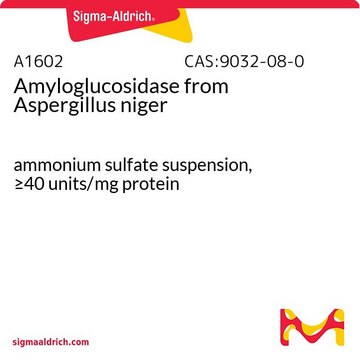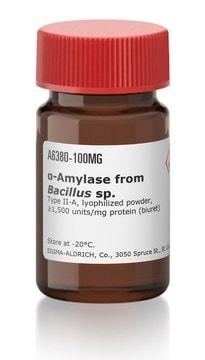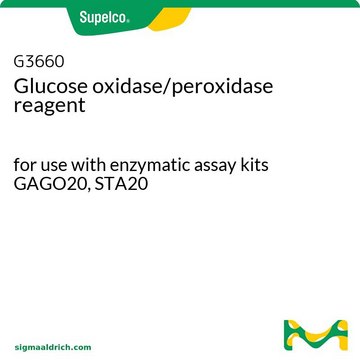ROAMYGL
Roche
Amyloglucosidase
from Aspergillus niger
Synonym(s):
Glucoamylase, disaccharidase-type-α-D-glucosidase
Sign Into View Organizational & Contract Pricing
All Photos(1)
About This Item
Recommended Products
biological source
Aspergillus niger
Quality Level
form
suspension
specific activity
~14 units/mg protein (At 25 °C with glycogen as the substrate; standardized with BSA.)
mol wt
Mr 97 kDa
packaging
pkg of 10 mL (10102857001 [100 mg])
manufacturer/tradename
Roche
parameter
55 °C optimum reaction temp.
optimum pH
4.6-4.8
storage temp.
2-8°C
Related Categories
General description
Amyloglucosidase is synthesized by several Aspergillus genus species. It is a disaccharidase–type α-glucosidase. This enzyme is an exo-enzyme and one of the major industrial enzymes. The stability of amyloglucosidase can be increased by immobilization.
Specificity
Cleaves terminal glucoses that are α1,4- or α1,6-linked to an oligo- or polysaccharide of multiple glucose units. The product is D-glucose.
Heat inactivation: Heat inactivation is recommended at 80 °C for 45 minutes, followed by rapidly cooling down.
Heat inactivation: Heat inactivation is recommended at 80 °C for 45 minutes, followed by rapidly cooling down.
Application
Amyloglucosidase from Aspergillus niger can be used for the hydrolyzation of terminal α1,4- and α1,6-glucosidic bonds (glucose-glucose bonds) in polysaccharides (e.g., starch, dextrins, glycogen), removing glucose units sequentially from the non-reducing end of the molecule. The enzyme will also cleave maltose and maltosides (maltotriose, maltotetraose, etc.).
Biochem/physiol Actions
Amyloglucosidase from Aspergillus niger is capable of hydrolyzing the α-D-(1-4), the α-D-(1-6), and the α-D-(1-3) glucosidic bonds of oligosaccharides. Amyloglucosidase is an extracellular enzyme that converts starch to dextrins and glucose. The enzyme is used in the starch-processing industry for the commercial production of D-glucose from corn syrups.
Unit Definition
Unit Conversion: One unit (+25 °C; glycogen as substrate) corresponds to 8.6 U (+60 °C; starch as substrate).
Physical form
Suspension in 3.2 M ammonium sulfate solution, pH approximately 6
Other Notes
For life science research only. Not for use in diagnostic procedures.
Storage Class Code
12 - Non Combustible Liquids
WGK
WGK 1
Flash Point(F)
does not flash
Flash Point(C)
does not flash
Choose from one of the most recent versions:
Already Own This Product?
Find documentation for the products that you have recently purchased in the Document Library.
Customers Also Viewed
Recent Advances in Basic and Applied Aspects of Industrial Catalysis (1998)
A A Amirul et al.
Folia microbiologica, 41(2), 165-174 (1996-01-01)
A. niger produced alpha-glucosidase, alpha-amylase and two forms of glucoamylase when grown in a liquid medium containing raw tapioca starch as the carbon source. The glucoamylases, which formed the dominant components of amylolytic activity manifested by the organism, were purified
High-potency amyloglucosidase-producing mold of the Aspergillus niger group.
Smiley KL, et al.
Applied Microbiology, 12(5), 455-455 (1964)
Nicholson N.
Biodiversity: New Leads for the Pharmaceutical and Agrochemical Industries (2000)
Recent Advances in Basic and Applied Aspects of Industrial Catalysis (1998)
Global Trade Item Number
| SKU | GTIN |
|---|---|
| 10102857001 | 4061838665492 |
Our team of scientists has experience in all areas of research including Life Science, Material Science, Chemical Synthesis, Chromatography, Analytical and many others.
Contact Technical Service









